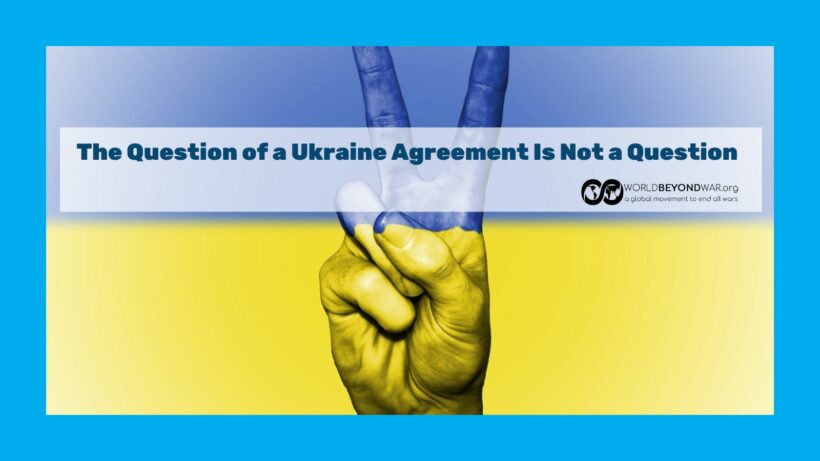The question of a Ukraine agreement is not a question, for two reasons. One, the warmaking parties want the war to continue. Two, if they were willing to make an agreement, everybody on all sides knows exactly (or darn near exactly) what it would have to be, and always has. Sooner or later, it will have to be agreed to, or the world end. (Yes, I’m aware that post-nuclear-apocalypse a rock will still be here with possibly some cockroaches on it; I just don’t find that particularly interesting.)
If we look at the Minsk II agreement in place prior to the war, compliance with which would have avoided the war, or at the proposals Russia was making just before its invasion, or the proposal from Italy last year (also here), or the proposal recently made by China, or the proposals from war-supporting stink tanks in the U.S. such as Brookings and the Center for the National Interest, we find that they share in common these points:
Ceasefire.
All foreign military forces out of Ukraine.
(Only China does not specifically state this, while it does state general principles that require it.)
Ukraine neutral / not in NATO.
(Only Minsk II does not say this, while China says it in its own vague way.)
Significant autonomy for the people of Crimea and Donbass to govern themselves as they see fit.
(Only Russia and China do not include this, and Minsk II does not mention Crimea; Italy says that these autonomous regions will be part of Ukraine, while the think tanks and Minsk II say that Donbass with be part of Ukraine, and the think tanks say that Crimea will be part of Russia. The National Interest proposes that Luhansk and Donetsk vote on their fate, and presumably does not say the same for Crimea only because Crimea already has voted and absolutely everyone knows how it would vote if it were to vote again.)
Demilitarization.
(While the details vary, all agree on the need to reduce the high level of weaponization, troops, and war preparations in the region.)
Ending sanctions.
(Only the two proposals that pre-date the recent sanctions on Russia fail to include the need to end unilateral sanctions.)
Rule of Law.
(All agree, only with variations in the details and hypocrisies, on the need to strengthen the international rule of law and the United Nations — except for the National Interest.)
Peaceful Relations.
(All agree on the need to establish peaceful, diplomatic relations, provide humanitarian aid, and — using other language — advance some process of truth and reconciliation.)
The fact that the above outline of an agreement is known to all is further suggested by the fact that Ukraine and Russia darn near agreed to it in March of 2022, before the U.S. and UK pressured Ukraine to keep the war going. Here’s a relevant bit from Medea Benjamin’s and Nicolas Davies’ book War in Ukraine: Making Sense of a Senseless Conflict:
“On March 10, the foreign ministers of Russia and Ukraine met in Antalya, Turkey, with Turkish Foreign Minister Mevlüt Çavuşoğlu mediating. These talks continued by video conference from March 14 to 17, with Israel as a second mediator, and produced a 15-point plan that Zelenskyy called ‘more realistic’ than previous proposals. The main points of the plan were for a cease-fire and Russian withdrawal, and for Ukraine to adopt a neutral status similar to that of Austria. Ukraine would renounce any future plan to join NATO and promise not to host foreign weapons installations or military bases, in exchange for new security guarantees from other countries. The Russian language would also be recognized as an official language in Ukraine. Russia’s sticking points involved the nature of the security guarantees and which countries would provide them, and the details of how the future of Crimea and the two People’s Republics in Donbas would be decided. But the outlines of a peace settlement were on the table.”
Until they weren’t. But it’s not as though we don’t still know what they are.






